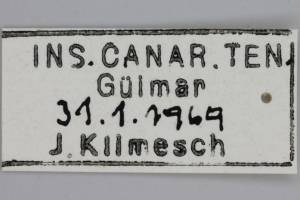1. Lebendfotos
1.1. Falter
2. Diagnose
2.1. Männchen
2.2. Geschlecht nicht bestimmt
2.3. Genitalien
2.3.1. Männchen
2.4. Erstbeschreibung
3. Biologie
3.1. Habitat
3.2. Nahrung der Raupe
- [Lamiaceae:] Marrubium vulgare (Gewöhnlicher Andorn)
- [Lamiaceae:] Sideritis hirsuta (Haar-Gliedkraut)
Klimesch (1987: 303) berichtet zum Synonym Eucelis marrubiana: "Lebensweise und Vorkommen: Walsingham fand die Raupe in den Samen von Marrubium vulgare worin auch die Verpuppung stattfand. Bisher nur in den Mittellagen der Trockenzone festgestellt." Walsingham (1907: 1007) berichtete konkret: "Taken, and bred: very common on the top of the hill of Guimar. The larva feeds on the seeds of Marrubium, the empty pupa-cases protruding conspicuously from the dry seed-vessels of the previous year." Zuvor hatte er die Pflanze mit "Marrubium vulgare" konkretisiert.
Chrétien (1917: 466-467) meldete per Fußnote zum Synonym Grapholitha nougatana: "La chenille de G. nougatana ne vit pas seulement sur le Marrubium vulgare L.; je l'ai trouvée, ayant les mêmes moeurs, sur le Sideritis hirsuta L." - er benennt diese Tiere als "sideritana, n. var.".
(Autor: Erwin Rennwald)
4. Weitere Informationen
4.1. Andere Kombinationen
- Penthina pauperculana Staudinger, 1859 [Originalkombination]
4.2. Synonyme
- Grapholitha nougatana Chrétien, 1898
- Endothenia nougatana (Chrétien, 1898)
- Eucelis marrubiana Walsingham, 1907
- Endothenia marrubiana (Walsingham, 1907)
- Endothenia sideritana (Chrétien, 1917)
- Polychrosis schmidti Rebel, 1936
- Endothenia schmidti (Rebel, 1936)
- Lobesia schmidti (Rebel, 1936) [so bei Karsholt & Razowski (1996): Nr. 4792]
4.3. Faunistik
Nach SwissLepTeam (2010) ist es fraglich, ob es in der Schweiz Vorkommen dieser Art gibt bzw. gab.
Locus typicus: Spanien, Andalusien, vic. Chiclana.
4.4. Literatur
- Baixeras, J. & M. Dominguez (1994): A revision of four species of Olethreutinae described from Spain (Lepidoptera : Tortricidae). — Annales de la Société Entomologique de France N. S. 30 (3): 345-359. [Digitalisat auf gallica.bnf.fr]
- Chrétien, P. (1917): Contribution à la connaissance des lépidoptères du nord de l'Afrique. Notes biologiques et critiques. — Annales de la Société entomologique de France 85 (3-4): 369-502.
- Klimesch, J.W. (1987): Beiträge zur Kenntnis der Microlepidopteren-Fauna des Kanarischen Archipels. 9. Beitrag: Tortricidae, Cochylidae. — Vieraea 17: 297-322. [Digitalisat auf bibdigital.rjb.csic.es]
- Erstbeschreibung: Staudinger, O. (1859): Diagnose nebst kurzen Beschreibungen neuer andalusischer Lepidopteren. — Entomologische Zeitung 20 (7-9): 211-259. Stettin.
- SwissLepTeam (2010). Die Schmetterlinge (Lepidoptera) der Schweiz: Eine kommentierte, systematisch-faunistische Liste. — Fauna Helvetica 25. Neuchâtel (CSCF & SEG).
- Beschreibung als Polychrosis schmidti: Rebel, H. (1936): Zwei neue mediterrane Microlepidopteren. — Zeitschrift des Österreichischen Entomologen-Vereines 21: 22-24. [PDF auf zobodat.at]
- Beschreibung als Eucelis marrubiana: Walsingham (1907): Microlepidoptera of Tenerife. — The Proceedings of the Zoological Society of London for the Year 1907: 911-1034 + pl. LI-LIII. [Digitalisat auf biodiversitylibrary.org]




![Vorkommen in Frankreich (europäisches Territorium ohne Korsika) [Vandromme et al. (2020): Liste systématique et taxinomique des Lépidoptères de France]](/res/img/flag/fr.gif)
![Vorkommen in Spanien (Festland) [Vives Moreno A. (2014)]](/res/img/flag/es.gif)
![Vorkommen auf den Kanarischen Inseln [Vives Moreno, A. (2014)]](/res/img/flag/es-cn.png)
![Vorkommen in Portugal (Festland) [Corley (2015): Lepidoptera of Continental Portugal]](/res/img/flag/pt.gif)

















